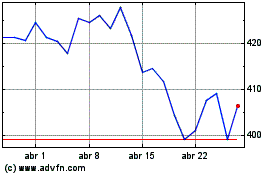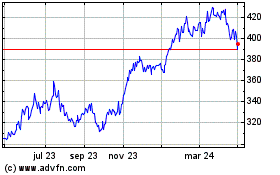Steve Ballmer on 'Tricks' of the Trade
11 Enero 2019 - 6:29AM
Noticias Dow Jones
By John D. Stoll
Former Microsoft Corp. Chief Executive Steve Ballmer refers to
the biggest industry-shaping innovations as locomotives, or tricks.
Microsoft's Windows and Office suite, for example, represent a
trick.
Among the things he's learned in business: It's hard to come up
with trick after trick.
Take, for instance, Apple Inc. Mr. Ballmer's longtime rival
faces questions about its next trick after the iPhone. Or take
Amazon.com Inc., which has created two tricks (web services and
online retail) and is following Microsoft's lead of trying to make
a hardware business a third trick, Mr. Ballmer says.
For evidence of how hard it is to churn out hits, Mr. Ballmer
references the music business. "Artists really do two big bodies of
work -- sometimes you'll have two albums quickly in succession, but
do you ever come back with a third that really takes off?" As an
oldies fan, Mr. Ballmer says history suggests there is one small
window of productivity for musicians.
Mr. Ballmer, who now owns a professional basketball team and
commits time to philanthropy, discussed with The Wall Street
Journal how difficult hit-making can be for even the biggest tech
companies in the world. Here are edited excerpts:
The Wall Street Journal: How does a CEO deal with the
expectation that the company will continue to come up with
groundbreaking innovation?
Mr. Ballmer: One way to grow a business is by starting up what I
would call a new locomotive -- a powerful business engine that can
really grow and pull other things with it. I've used the word
"trick" to describe that.
A second way to grow a business is to be in that phase where
you've achieved some liftoff on a locomotive and you just need to
drive it, including what I would call cabooses. Those are the line
extensions and new features that help you maximize what you can get
out of a locomotive.
When I say it's hard to be a two-trick pony, that means it's
really hard to do a second and almost impossible for companies to
do a third trick.
WSJ: There are now questions whether Apple can continue to churn
out products that are hits. How do you assess that challenge?
Mr. Ballmer: Apple is an amazing company. They have done two
tricks. I find that impressive, stunning, positive. I call the Mac
one trick and the iSeries a second trick.
I also give them credit because when they started out on the
iSeries, it wasn't a trick. It was more like one of these cabooses,
but they kept after it. If they had stopped at the iPod, where
would they be? Nowhere, essentially. But the [company's] view that
increased miniaturization and low power could do amazing things
allowed them to push beyond the iPod and do something truly
amazing.
WSJ: What about Microsoft?
Mr. Ballmer: At Microsoft, we also did two amazing tricks. The
first trick I basically call desktop computing, that includes
Windows and Office. The second trick for Microsoft was to be an
enterprise software company.
Those were two major tricks and they have been kept alive --
starting on my watch but really perpetuated on current CEO Satya
Nadella's watch -- in the form of cloud-based desktop computing and
cloud-based enterprise computing.
WSJ: How did Microsoft keep its footing?
Mr. Ballmer: People often get their core tricks blown up by a
technology transformation. That didn't happen at Microsoft and I
consider that a great job. Eventually, if you're a one-trick pony,
the other thing that can happen to you is you don't keep relevant
with the times.
WSJ: Why do big companies sometimes struggle with coming up with
meaningfully new ideas?
Mr. Ballmer: It's just really hard to do a trick whether you're
a startup or a big company. If you look at most venture-financed
companies, what percentage of them really stay independent? They
mostly become dead or their features are bought up by other
companies.
It's amazing to do one trick, it's super amazing to do two. To
do three? Wow, wow. I have a lot of respect for a company that can
do three tricks and I hope my former company can continue to get
mileage out of the two tricks but come up with a third.
WSJ: What are some specific roadblocks for big companies?
Mr. Ballmer: At a bigger company, because some of these things
start out so small, [potential new tricks] don't look like they'll
be additive anytime soon to the bottom line. Having management, the
board, investors stay patient with a new trick is hard because it
looks small or like a profit-drainer.
In a large company, you can also over-resource a new trick,
trying to get it to be too big too fast. I'll give Apple credit
because they didn't overspend on the iSeries and they didn't
overfeed it. You have to be patient.
Write to John D. Stoll at john.stoll@wsj.com
(END) Dow Jones Newswires
January 11, 2019 07:14 ET (12:14 GMT)
Copyright (c) 2019 Dow Jones & Company, Inc.
Microsoft (NASDAQ:MSFT)
Gráfica de Acción Histórica
De Mar 2024 a Abr 2024

Microsoft (NASDAQ:MSFT)
Gráfica de Acción Histórica
De Abr 2023 a Abr 2024
